Making vinegar from apple scraps is the ultimate in reducing food waste because it gives fruit scraps a second life. Better still, homemade vinegars are super easy and cheap to make, and have many uses in the kitchen and around the home.
Before we go any further, let’s quickly address the question:
Is apple scrap vinegar the same as apple cider vinegar?
The short answer – no. While you can use the vinegars in much the same way for cooking, salad dressings, hair rinses etc, the process and materials needed to make apple cider vinegar differs.
Apple peel vinegar, apple core vinegar and apple scrap vinegar are made the same way, and are so simple to make. You can read more on making apple cider vinegar, also known as ACV, here.
Making Apple Vinegar from Scraps
The first time I made apple vinegar from scraps was after filling a basket of apples when I visited my friend Jill, at Hallston Valley Farm. I dried them, jammed them and of course made apple pie, which left me with a load of apple peels and cores, which seemed too good for compost, as apple skins are packed full of nutrition.
Not everyone has a friend, with an abundance of homegrown fruit. And when I don’t have enough apple scraps at one time, I freeze apple cores and peels, until I have enough to fill a jar. You can also use bruised or second quality apples to make vinegar too, so if you have apples in the fruit bowl past their best, just pop them in the freezer until you’re ready.
Apple scrap vinegar recipe
One of the great things about making apple scrap vinegar is that you can be approximate with the measurements. There’s no need to accurately measure and weigh everything. You just need enough to let the natural science work. To start you’ll need:
Equipment
- Large glass or ceramic jar/bowl (one in picture is 1L)
- Breathable cloth for covering the jar e.g. muslin, cotton or paper towel
- Elastic band
- Colander or large sieve
Ingredients
- Apple scraps – peels and cores
- Sugar (1 Tbsp)
- Boiling water (1 Tbsp)
- Room temperature water -filtered or boiled and cooled (about 500 ml or 2 cups)
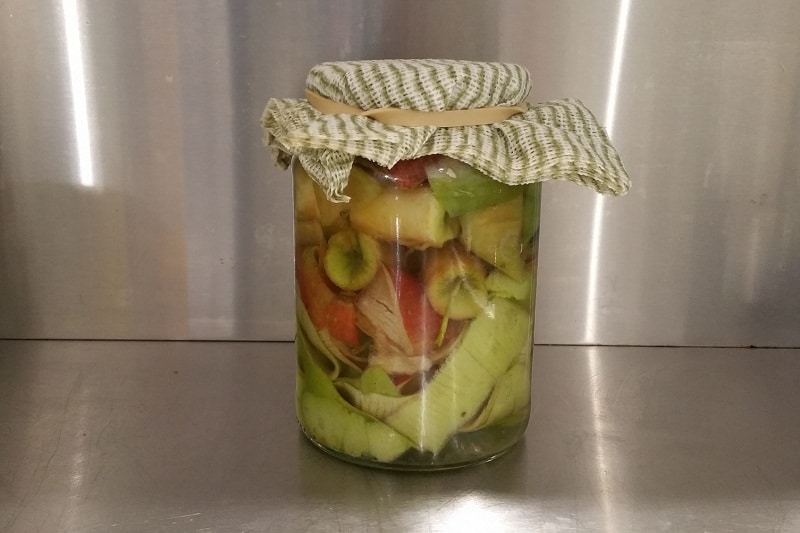
Method
Loosely pack apple scraps into a clean glass jar to just under full (about 6-8 apples to fill this jar).
Dissolve sugar in a small amount of boiling water and pour into jar.
Fill the jar with room temperature water until it fully covers the apples.
Cover the jar with a cloth or paper towel and secure with an elastic band.
Keep it at room temperature, away from direct sunlight. I keep it on the bench where I’ll see it and remember to check it, or the pantry is fine too.
Check it every few days. Push the floating apple scraps down, ensuring they’re submerged or they might go mouldy. You can use a weight on this, if you’re likely to forget.
From apple scraps to apple scrap vinegar – Stage 1
Over the next few days, you’ll see the liquid bubble slightly on top and you’ll notice it more when you resubmerge the apples. The bubbling happens thanks to the acetobacter which converts the sugars, to create vinegar. If you’re curious about the science of this, you can read more here.
It will have an acidic smell, which might seem a bit wrong at first. But that’s what’s meant to happen as it turns into vinegar.
When the floating apple pieces sink to the bottom and the bubbling stops, your vinegar is ready for the next stage. This fermentation stage can take from 2-6 weeks, dependent on the weather – it’s faster when it’s warmer.
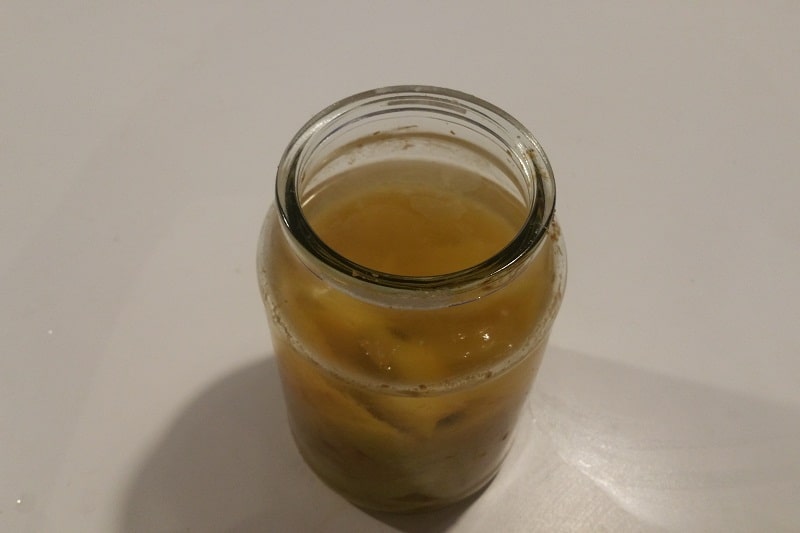
Homemade apple vinegar – Stage 2
Once the natural sugars and goodness from the apples have been extracted, it’s time to decant the liquid into a clean jar.
Stand the colander or large sieve in a large bowl, with the cloth or muslin lining the inside and strain the apple mixture through it. The finer the cloth, the more sediment you’ll hold back. It’s fine if the sediment slips through, it can just make the final product a little cloudy.
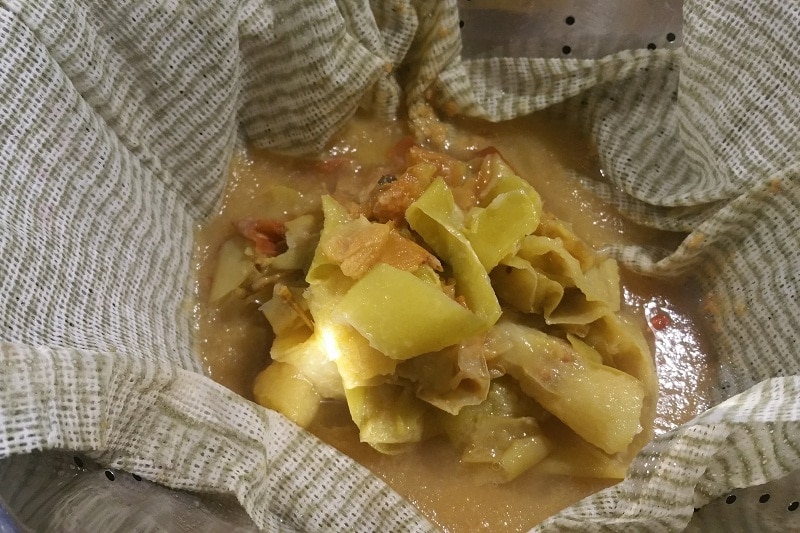
Squeeze out as much of the vinegar as you can.
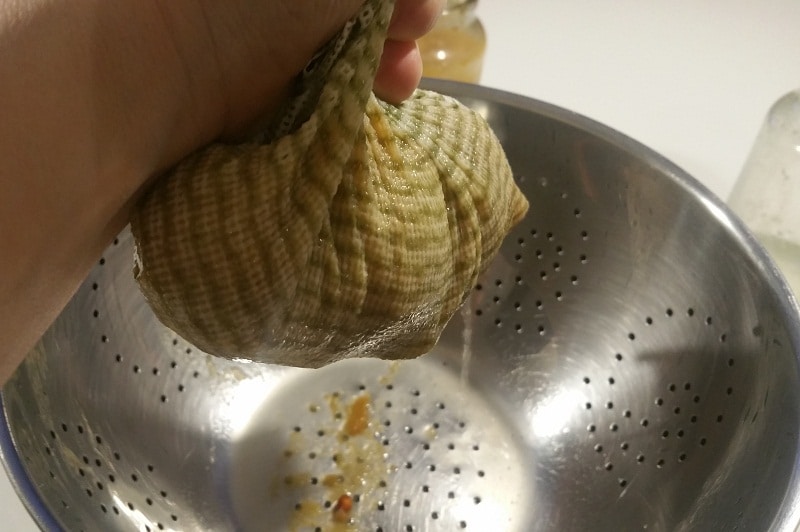
Cover again and leave in a cool dark spot for a couple of weeks, but it gets even better if you leave it for a few months.
Give it a taste every 7-10 days, or when you think of it (leaving for a month is fine too) and give it a quick swirl to aerate it. When you’re happy with the taste, it’s done. Put a lid on it and store in dark place. While a dark glass jar is ideal, a clear glass jar is fine if you store your apple vinegar out of direct sunlight.
What is an apple vinegar mother?
Creating a mother is like hitting the vinegar-making jackpot because you can add it to your next batch of apple vinegar, or any vinegar, and it will speed up the process and sharpen the acidic taste. Hence it can ‘birth’ or create more vinegar.
If you see white cobweb-like strands, or what seems like a layer of white scum on top of the vinegar, this is the vinegar mother forming. If left alone it will develop into a gelatinous blob, and this is what you want. If you mess with it, it will sink which is fine. If there’s enough sugars left in the liquid a new mother may form on top again.
You can also use the mother from apple vinegars to make red or white wine vinegar or real apple cider vinegar.
How to make a vinegar mother?
There’s no secret to making a vinegar mother. All you need is time and patience.
The first time I made a vinegar mother, it wasn’t intentional. I’d completed Stage 1 and then put the jar in the cupboard and forgot about it. I let it sit and do its thing. When I went and checked back in, the mother had started to form.
If you’re not expecting it, can look a bit wrong at first. You could almost confuse it with mould. If it’s white in colour, and slimy looking, it’s likely to be a mother in the making. If you see this, then leave it alone, as needs time to form.
Although I know the science behind vinegar mothers, I still get excited when I see one form with a new batch of vinegar. It’s like natures magic to me.
How to make wine vinegar with an apple vinegar mother
No need to keep buying red or white wine vinegar from the store. It’s easy enough to make and all you need is a small amount of wine to start this process.
Grab that half open bottle you forgot to drink and simply add your apple vinegar mother to it. Cover it, with a cloth, then leave it for a few weeks (a couple of months gives a deeper flavour).
Taste it as you go, as you did for your apple scrap vinegar. When the taste is sharp enough for your liking, you’re done. It’s that easy.
And I know some of you are thinking, who has leftover wine?
Trust me, this is so much better than store bought wine vinegars. Once you try it, you’ll make sure there’s left over wine. You can be a purist with varieties e.g. shiraz vinegar, chardonnay vinegar, pinot vinegar etc. But it’s fine to mix the varieties if you have small amounts.
I do either a red wine vinegar, or a white wine vinegar, but you can experiment and mix them if you want to.
Apple scrap vinegar vs apple cider vinegar
So, what’s the difference?
Apple cider vinegar is literally what the name indicates, a vinegar made from apple cider. Don’t be misled by the many blogs which suggest you can make apple cider vinegar with scraps. It’s NOT the same process.
Real homemade apple cider vinegar
If you want real apple cider vinegar, you need to either use apple cider, or juice apples and go through two distinct stages of fermentation. You can use second fruit (although commercial producers tend not to). This is how to make real apple cider vinegar.
An easier way to make homemade apple cider vinegar at home, is when you develop a mother, as described above. You can add a mother to left over cider in the same way you do for making wine vinegar.
Alternatively, you can get raw apple cider vinegar with mother and add that to your apple cider.
The science of vinegars
Acetobacter aceti are described as “vinegar bacteria”. They’re a good bacteria which occur naturally and are widespread in the environment, particularly on fruit skins. The vinegar forms in an oxidative fermentation to form acetic acid, which is the basis for producing vinegar. This simply means it’s an aerated process.
Apple scrap vinegar is a wild ferment, relying on this naturally occurring bacteria. When you add sugar, it effectively feeds the bacteria. The bacteria metabolise, or break down the sugars, and the byproduct is acetic acid which is the basis for vinegar.
Without adding sugar to create vinegar, the process may be slower, or it may not happen at all. I’ve experimented by not adding sugar, and without sugar it went mouldy. So yes, you need to add sugar if you want to make vinegar from fruit scraps, but the sugar won’t remain in the finished vinegar. If you’re fascinated by the science of vinegar, you can get your science nerd on here.
More vinegar trivia, is that the formation of vinegar was first documented in 1868 by Louis Pasteur, a French chemist and microbiologist. Pasteur is credited with saving France’s wine industry, a noted accomplishment. Although he is better know for developing milk pasteurisation, which is a technique developed to increase the shelf life of wine. Pasteur originally named the bacteria Mycoderma aceti. In 1898 Martinus W. Beijerinck, a dutch microbiologist and botanist, reclassified it as Acetobacter aceti.
Homemade apple vinegar tips
- The measurements are a guide, you don’t need to be exact with this, and it’s ok if the jar isn’t full.
- Freeze apples scraps until you have enough to make a batch.
- If you have bruised apples you can cut them up and use them. You can cut mould out, but don’t use mould in the vinegar.
- Filtered or rain water is ideal. Otherwise boil and cool it to get rid of the chlorine. Don’t use plastic bottled water.
- It’s preferable to use organic apples, where possible, as conventional apples are one of the most pesticide laden fruits.
- Don’t be concerned by the sugar, this feeds the Acetobacter which uses up the sugar. Adding more sugar can give the vinegar a sharper taste.
- You can give the residual apple scraps to animals or compost them.
- I’ve read you shouldn’t use apple scrap vinegar for pickling. BUT I tried it anyway, and you can. I didn’t dilute it with as much water for pickling. And I used it for pickles that were to be used in the short term and stored in the fridge. I’ll be experimenting more.
Have you made apple vinegar from scraps? I’d love to hear how you went.
Or if you have any questions? Ask away and I’ll do my best to answer them.

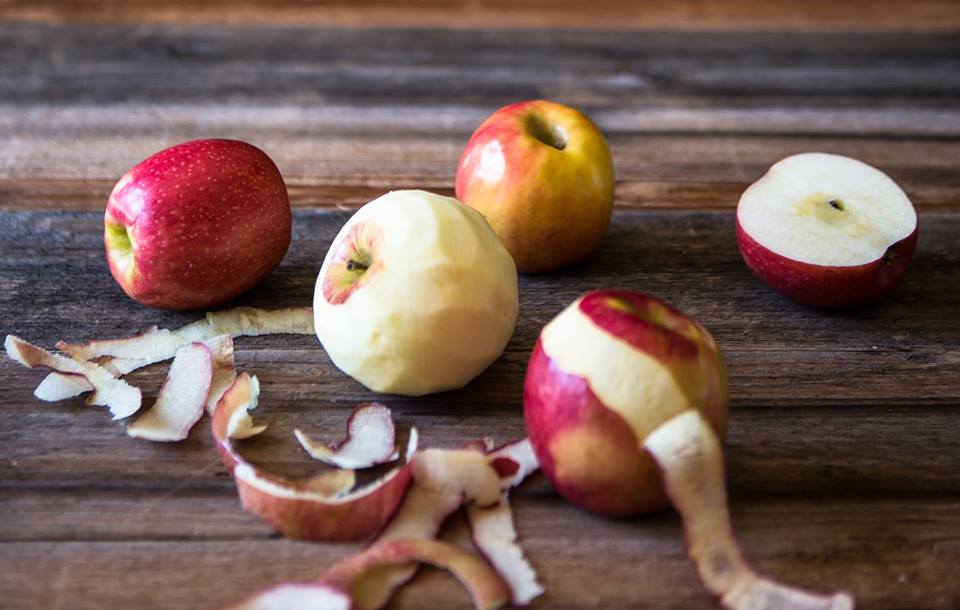

Thanks regarding providing many of these terrific posting. Brilliant use of apple scraps to make vinegar
I really enjoy the post. I would like to try apple scrap vinegar.
Really thank you! Awesome.
Hello…
I have 3 half gallon jars of apple scrap vinegar I started 17 days ago .it now has a white transparent like film on top of each jar that seems to get a little thicker each day..one jar has a few string like stuff going downward about half an inch..my question is what to do now .I still have a coffee filter for the lid..should I take it out and bottle it .my kids aren’t sure that it’s safe to taste..it’s obvious I don’t know what I’m doing..maybe you would share some advice..thank you from WV
Good to know how to make apple scrap vinegar. I will try this.
Much thanks again.
Oh wow, you can make apple cider vinegar with apple waste and no mother? Wow amazing. I must try this.
I loved your post. Really looking forward to making apple scrap vinegar. Really Cool. Chandra Wallis
I did not know you could make fruit vinegars without a mother. But is it better with a mother?